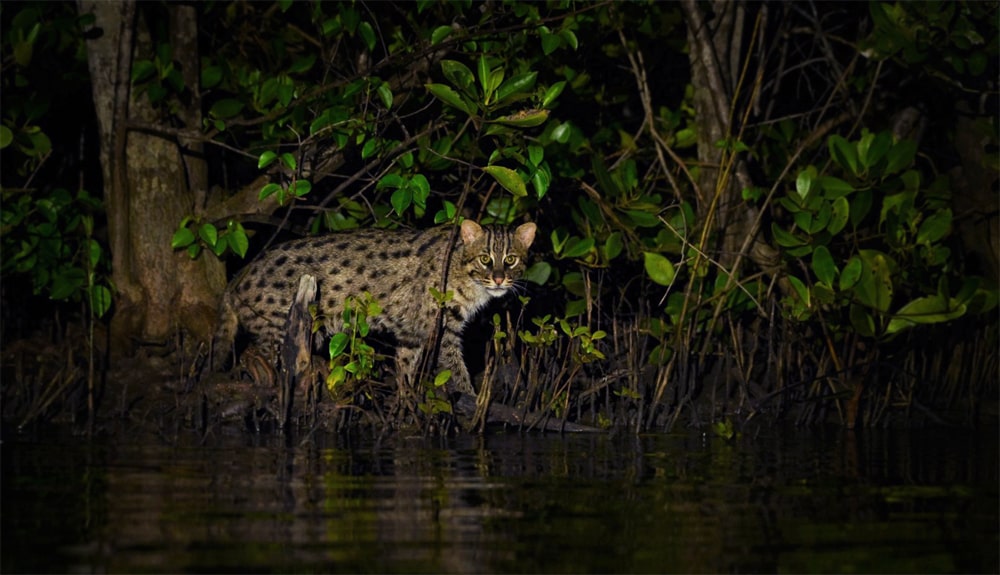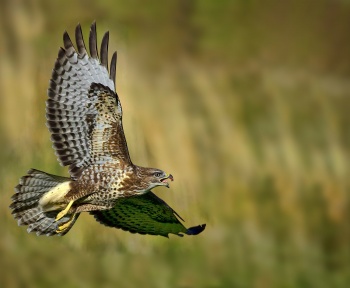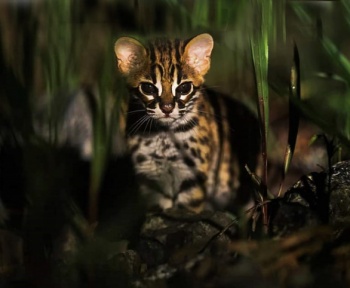Sundarbans is known for the world’s largest evergreen mangrove forests. It has marvelous biodiversity with various important ecological functions.
Sundarbans is home to many aquatic species on the east coast of India. Sundarbans is famous for the world’s best tiger reserve & best tiger safari in India. However, animals like the leopard cat, Fishing cat, and certain species are rarely seen because of their nocturnal habits. The fishing cats are abundantly seen in Sundarbans of West Bengal.
The Fishing cat is a wild fish-eating cat. The scientific name of the fishing cat is Prionailurus viverrinus. It belongs to the family Felidae, the genus Prionailurus and the species viverrinus.
Locally, it is called Baghrol or Macch Bagha (in Bengali), It has different local names in different states Meseka in Assamese, Bunbiral, and Khupyabagh in Hindi, Bavurupilli in Telugu.
Do you know… the fishing cat was declared as the state animal in 2012. The fishing cat has its importance in the mangroves, rivers, and floodplains of West Bengal.
The Calcutta college and the zoological study of India are leading its first state-wide review this year, just to know the present status of the species. The study appointed by the West Bengal biodiversity board avoids ensured territories.
Fishing Cat appearance –
The fishing cat has yellowish-grey fur. The fur on the sides and back are darker and the fur on the belly is lighter. The fur is layered to adapt to the water.
The dense, tiny layer acts as a barrier to water and heat while another long layer provides its sheen.
The background color of the fur is different for each one of them. The color varies from yellowish-brown to ash grey. The black lines and spots add beauty to the fishing cat. It possesses two stripes on the cheeks and two above the eyes extending to the neck. The lines on the forehead are broken. The throat is encircled by two rows of spots. The spots over the sides, limbs, and tail are round and over the shoulder are longitudinal. Black hair is present on the back of the ears with a white spot in the middle.
The fishing cat looks beautiful with an elongated face, small rounded ears positioned low and far back on the head, short legs, and a short tail. The tail has partial black rings at the end which are used as a rudder during swimming.
The unique feature of the fishing cat is its partially webbed feet which help to travel in water and wet soils. The claws are retractable so that they can protrude as they are incompletely sheathed.
The fishing cat resembles more of a leopard cat. They are differentiated from the leopard cat by the retractable claws.
They are medium-sized animals two times heavier than the house cat. The adult feline weighs around 5-16kg. The males are heavier than the females. Their length measures between 57-78cm. At birth, the kittens weigh around 170g. The average life span of a fishing cat is about 12 years.
wait the beauty of the fishing cats persuades you to go for an excursion and capture the beauty of the fishing cat? If so then go for a Sundarbans wildlife photography tour and capture the beauty of nature.
Fishing Cat habitat –
The fishing cats are abundant in the mangrove swamps, rivers, and floodplains of West Bengal.
They are also seen in marshes, reedbeds, sluggish rivers, streams, lakes, etc. the freshwater habitats are the most commonly preferred habitat. The unique features of the fishing cat allow it to survive in wet and watery conditions.
Distribution of Fishing Cat –
The fishing cats are widely distributed. At present they are seen in India, Sri Lanka, Nepal, Bangladesh.
In India, the majority of the fishing cats live in the mangrove forests of Sundarbans, on the foothills of the Himalayas, and in the Western Ghats.
The felines are also found in Ranthambore Tiger Reserve in Pilibhit, Dudhwa, Valmiki Tiger Reserve, in Sur Sarovar Bird Sanctuary, Bhitarkanika Wildlife Sanctuary in Odhisha, Coring Wildlife Sanctuary in Andhra Pradesh, Krishna Wildlife Sanctuary.
Fishing Cat diet –
The fishing cat is piscivores. As the name suggests, the fishing cat considers fish in the wetland areas as their main prey.
They are good swimmers. They have a unique method to catch the fish. They glaze the water surface with their paws like an insect. Once the fish comes to the surface it becomes prey to the fishing cat.
But they also eat crabs, crayfish, frogs, birds, small rodents, mollusks, insects, and snakes. Rarely feed on goats, pigs, and dead bodies of domestic cattle.
Behavior and reproduction –
The felines are nocturnal animals who prefer to remain in solitary spending their nights quietly during the non-breeding season. The males have a big territory than the females.
Fishing cats use various mannerisms for marking their territory. They are Cheek-rubbing, head rubbing, chin rubbing, neck rubbing, and urine spraying to leave scent marks.
The fishing cat breeds once a year commonly during January and February while most of the kittens are born during March and April. During the breeding season, the females find their potential mates by the scent markings used on the edge of their territory.
After mating, the females build a den with dense shrubs or reeds to give birth to the kittens. The gestation period is for about sixty-three to seventy days. The females give birth to one to four kittens (usually two in number).
At birth, the kittens are blind. They take nearly two weeks to open their eyes.
The kittens start taking solid food by two months of age and completely weaned at about six months. By eight months of age, they reach their adult size and begin to live independently by 10 to 15 months. By 11months they acquire their adult canine teeth.
The kittens keep their first baby steps in the water around 2 months old. They love to play in the water and they use the water for hunting fish. In captivity, the male fishing cat helps the female in providing care for the kittens.
Communication –
The fishing cat communicates by hisses, meows, and staccato growls. They make chittering sounds during courtship.
Can a Fishing Cat be a pet?
Unfortunately, the fishing cats can’t be good pets as they are wild cats with sharp teeth and claws which they use to defend themselves during threats.
Are Fishing Cats dangerous to humans?
Not. They are 3 feet long and weigh about 11-30 pounds. They prefer to avoid contact with humans. Thereby fishing cats do not attack humans.
Very little information is known about the presence and distribution of these wild cat species in various parts of India.
Conservation Status –
The fishing cat is listed as Endangered in the IUCN and CITES red list. To protect them from hunting, these felines have been included in Schedule 1 of the Indian Wildlife (Protection) Act, 1972. Under this act, the offender is punished with imprisonment for a maximum of three years or a fine up to Rs.25,000 or both. At present, approximately less than 10,000 fishing cats are left in the world.
These species are endangered because of activities like woodcutting, excessive fishing, hunting by humans, and pollution of the wetlands. To reverse the declining population the conservation efforts are undergone by creating awareness to the people and encouraging the locals by involving in the conservation activities. Preservation of wetland habitats is recommended as these habitats are their favorite place to live.
Various initiatives are undergone by the Sundarbans wildlife tourism to preserve these species. Another interesting fact is that they involve the local villagers in this wonderful initiative considering their socio-economic status.
The “fishing cat tourism” has taken an initiative through Sundarban wildlife tours to involve the local communities in the wetland habitats of West Bengal. The main aim of this initiative is to preserve the fishing cat population and their habitat.
If the beauty of the fishing cat, their interesting facts, and the scenic beauty of the Sundarbans tempts you to explore them, then get ready with your travel kits and the camera. Let us go for an adventurous journey and create memories of a lifetime.
Reference –
Wikipedia, WWF India, Wild Cat Conservation, BBC




